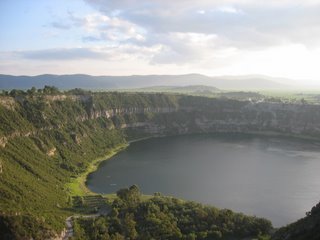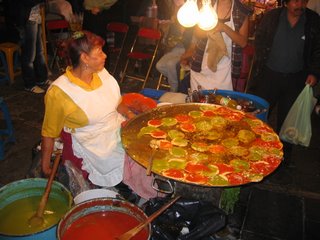
 The "Amexicana Dream" is More Sad Than it is Beautiful
The "Amexicana Dream" is More Sad Than it is Beautiful
Ajojaluca, Puebla – Francisco de la Luz Gutierrez, a strong, commanding figure at 44, stands comfortably behind the counter of his family’s brand new hardware store in the tiny, farming town of Ajojuca, which is set around an awe-inspiring natural lagoon in the mountains of Puebla, Mexico. Despite the town’s population of only 4000, business at the hardware store is busy for a Tuesday. Locals come in and out, and Francisco’s wife takes phone calls from clients purchasing cement, paint, and other basic construction materials. A brief tour of Ajojuca – where house upon house is under construction to add additional floors, replace traditional wood with cement and brick, and install new glass windows – makes it easy to understand why business is brisk.
“The money transfers from the U.S. sustain this town,” began Francisco, who has returned to Ajojuca after living in Santa Monica, California with his family for more than 25 years. “There is not one household here that does not have a family member in the U.S. In Ajojuca, the mentality is to go the United States to progress, because here it is very difficult to improve the standard of living for your family.”
Over the past 20 years, Ajojuca has experienced the same economic breakdown as other farming towns in this southeastern Mexican corridor. There has been a rapid decrease in rainfall at the same time that the price of crops – such as the traditional standard of beans and corn – has fallen by more than half. Despite governmental promises of subsidy programs and new industry, the blow to farmers as a result of Mexico’s increasing privatization and the international competition brought on by NAFTA, has not been ameliorated through the creation of alternative employment.
That is why, in 1980 – at the age of 18 and driven by a deep-felt responsibility to provide for his family – Francisco crossed the U.S./Mexican border without a formal education or even the money to pay a
coyote. He started working as a dishwasher and a landscape laborer, and he made the dangerous crossing back to Ajojuca every July so that he could visit his wife during the town’s annual festival.
After receiving legal worker status as a result of the 1986 U.S. Immigration Regulation Control Act (IRCA), Francisco brought his wife to the U.S., raised two sons and a daughter there, and eventually moved from working as a salesman at a nursery to starting his own private landscaping business. Finally in 2004, Francisco moved his now lawfully residing wife and U.S.-citizen children back to Ajojuca to reconnect with the family tradition of farming, raising chickens, and horse-wrangling.
“I was tired of the stress of the U.S., and I wanted to come home to my Mexican roots so that my children could develop an appreciation for where we are from,” Francisco continued while his two eldest sons walked in and out of the store, listening in to the conversation sporadically. “They miss the U.S., but I will not let them go back until they try life here for awhile, and learn to ride horses, raise chicken, and listen to some of our traditional Mexican music.”
Francisco and his family epitomize the “Amexicana Dream”, wherein families migrate to the U.S., improve their standard of living, and at the same time attempt to maintain their allegiance to Mexican culture, and eventually return to Mexico to live. Luckily for Francisco, he can now support his family from Ajojuca as a result of the money sent by other Ajojucan migrants now living throughout California, Texas, Colorado, Illinois, and New York. But just as the vibrant housing construction represents a temporary veneer over what is basically an economically depressed farming town, the “dreamy” aspect of Francisco and his family’s accomplishments hides a more complex reality.
The life that depends on migration is full of dreams that are incompatible with day-to-day actions. While the original goal may have been to improve family wellbeing, family wellbeing has been the hardest hit by the culture of migration and many migrant families are collapsing as a result of the division between two worlds.
Through tears, Maria de los Angeles Urbino, another Ajojucan whose hardware business has benefited from the dollars sent from the U.S., talks about her son, Luis, who went north a year ago to experience the wealth that his father had brought back after working as a laborer in California. “He did not have to go. Our family is doing well here, but there were disagreements between him and his father and he took off for the border.”
Luis represents a new group of migrants that do not have the same neccesity as their parents did, but who have grown up benefitting and hearing about the many opportunities del otro lado. “The truth is that Luis is not even doing that well in the U.S.,¨ Maria continues. “He tells me that he is living in a room packed with other migrants and that the gringos treat him like an animal. But he has something to prove to his father and so since September 2005, he has not returned.”
While the official census of Ajojuca indicates that one in nine residents migrate the U.S., Ajojuca’s registrar, Celina Despiderio Vasquez, believes that it is more like one in two – or in other words, somewhere between 1700-2000 of Ajojuca’s population of 4000 are living in the U.S.
“Today there are more career options here, but teenagers have their mind on the American dream rather than on studying in school,” Celina says matter of factly from her small unadorned government office. “Often, those who leave, are those with the least resources, the lowest level of education, and those whose families do not value the importance of education.”
The economic benefits from the large-scale migration are visible. Beyond the booming construction industry, Ajojuca’s catholic church has been repaired in the past two years from damage suffered in the 1996 earthquake, and new statues have been added with engravings indicating that they were donated by Ajojucans living in Denver, Colorado. The local school has been remodeled, cars abound, and a large community center is being built on the ledge of the Laguna.
Despite the remodeling of Ajojuca and the increasing financial opportunities, the culture of migration reigns, and teenagers continue to make the journey north. According to Francisco, “now immigration is more about the individual than about trying to make a better life for their families. Many wives and children suffer great sadness when husbands never return, or sometimes they return sick and addicted to drugs. They think, ‘I’ll just take a stroll north,’ but in the end, they don’t bring anything but sadness upon their families.”
The truth is, the migration situation is much more sad than it is beautiful,” Francisco concluded.
















